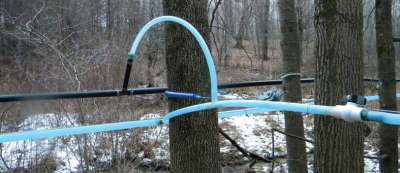Vacuum tubing systems have revolutionized maple sugar production, and more and more sugarmakers are getting into the game, drawn by the allure of making an average of .4 gallons of syrup per tap, compared to the .25 gallons in a traditional gravity system. To get this kind of boost, you need 25 or 26 inches of vacuum, not just at the releaser but in the sugarbush, and herein lies a problem. When the mainline is three-quarters full of sap, less vacuum reaches the trees high up in the sugarbush.
To remedy this, savvy producers use a wet line/dry line system, sometimes called a dual-line system. This entails having two parallel mainlines arranged one above the other. The lower line carries sap, while the upper line transfers vacuum to the far reaches of your woods. You can think of these two lines as an interstate highway system for the sap and vacuum.
At each mainline spur (the entrance/exit ramps in the highway analogy), you have to tie the dry line into the spur line so you can get vacuum to the trees. The equipment dealers would love to sell you a commercial manifold, called a vacuum booster, for each of these junctions to the tune of several hundred dollars a pop. But there is an easier way. All you’ll need is two mainline tees, a ball valve, and a handful of hose clamps.
The picture here shows a 1¼-inch wet line (blue) and a 1-inch dry line (black) running parallel to each other. The spur line coming in perpendicular and attaching to the wet line is ¾ inch. Note that a tee was added to the dry line and necked down to ¾ of an inch (you could also just use a 1-by-1-by-¾-inch tee and make your life easier), then connected to the spur line with a 3- or 4- foot piece of tubing. Finally, there’s a ball valve on the uphill side of this junction that will allow you to close off the spur line. A simple manifold that looks like this can be made for about $20, depending on your mainline size and the price of hose clamps at your hardware store. The vacuum can now be effectively transferred from the dry line to the wet spur line. Another thing to remember when building a dual-line system is to maintain proper pitch in both your wet and dry lines. Both lines need to have 3 to 5 percent slope to allow gravity to do its job. Otherwise, sap will pool in any sags in the mainline, blocking the progress of vacuum and sap.
And remember, too, that the dry line will periodically become a “wet” line. When the wet line is frozen, the sap is forced into the dry line. Once the wet line thaws, things go back to normal. The dry line will also provide a bit of excess capacity on those few days during the season when the trees are really gushing.
This sort of a system is not for everyone, but if you have long mainlines (over 1,000 feet), more than 700 taps on a mainline, and a properly sized vacuum pump, this system will bring high vacuum to all the trees in your sugarbush and cooler sap to your tank. And for those of you who don’t sugar, you’ll now know how to impress your sugaring friends by knowing the ins and outs of a dual-line system.
Thanks to the Vermont Maple Sugar Makers’ Association for holding a series of vacuum seminars this past year, and to J.R. Sloan, of Green Mountain Mainlines in Fairfield, Vermont, for sharing this trick with us.


